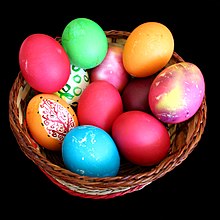ഈസ്റ്റർ മുട്ട

ഈസ്റ്റർ മുട്ടകൾ പാസ്കൽ മുട്ടകൾ എന്നും അറിയപ്പെടുന്നു. [1] അലങ്കാരമുട്ടകളായ ഇവ സാധാരണ ഈസ്റ്റർ സമയത്ത് സമ്മാനങ്ങൾ ആയി ഉപയോഗിക്കാറുണ്ട്. ഈസ്റ്റർ റ്റൈഡ് (ഈസ്റ്റർ സീസൺ) സീസണിൽ ഈസ്റ്റർ മുട്ടകൾ സാധാരണമാണ്. ചായം പൂശിയ ചിക്കൻ മുട്ട ഉപയോഗിക്കണം എന്നതാണ് ഏറ്റവും പഴയ പാരമ്പര്യരീതി , എന്നാൽ ആധുനിക രീതിയിൽ നിറമുള്ള ഫോയിൽ പേപ്പർ കൊണ്ട് പൊതിഞ്ഞ ചോക്ലേറ്റ് മുട്ടകൾ, കൈകൊണ്ട് നിർമ്മിച്ച തടിയിലുള്ള മുട്ടകൾ, അല്ലെങ്കിൽ ചോക്ലേറ്റ് നിറച്ച പ്ലാസ്റ്റിക് മുട്ടകൾ എന്നിവ ഉപയോഗിക്കുന്നു. എന്നിരുന്നാലും, കിഴക്കൻ യൂറോപ്യൻ പാരമ്പര്യത്തിൽ യഥാർത്ഥ മുട്ടകൾ ഉപയോഗിക്കുന്നത് തുടരുന്നു. മുട്ടകൾ, പൊതുവേ, പ്രത്യുൽപാദനത്തിനും പുനർജന്മത്തിനും പരമ്പരാഗത ചിഹ്നമായിരിക്കുന്നു.[2].യേശുക്രിസ്തുവിൻറെ ഒഴിഞ്ഞ ശവകല്ലറയുടെ അടയാളമായി, ഈസ്റ്റർ മുട്ടകൾ യേശുവിൻറെ പുനരുത്ഥാനത്തെ പ്രതീകപ്പെടുത്തുന്നു[3][4][5]
-
Ukrainian Easter eggs
-
Easter eggs from Sorbs
-
Easter eggs from Lithuania
-
Perforated egg from Germany, Sleeping Beauty
-
Norwegian Easter eggs
-
Easter eggs from Greece
-
Perforated eggs
-
Easter eggs from France
-
American Easter egg from the White House Washington, D.C.
-
Pace eggs boiled with onion skins and leaf patterns.
-
Easter eggs decorated with straw
-
Easter egg from Poland
-
Giant easter egg, Bariloche, Argentina
-
Giant pysanka from Vegreville, Alberta, Canada
-
Easter egg sculpture in Gogolin
ഇതും കാണുക[തിരുത്തുക]

അവലംബം[തിരുത്തുക]
- ↑ The Legend of Paschal Eggs (Holy Cross Antiochian Orthodox Church)
- ↑ David Leeming (2005). The Oxford Companion to World Mythology. Oxford University Press. Retrieved 10 March 2013.
For many, Easter is synonymous with fertility symbols such as the Easter Rabbit, Easter Eggs, and the Easter lily.
- ↑ Anne Jordan (5 April 2000). Christianity. Nelson Thornes. Retrieved 7 April 2012.
Easter eggs are used as a Christian symbol to represent the empty tomb. The outside of the egg looks dead but inside there is new life, which is going to break out. The Easter egg is a reminder that Jesus will rise from His tomb and bring new life. Orthodox Christians dye boiled eggs red to make red Easter eggs that represent the blood of Christ shed for the sins of the world.
- ↑ The Guardian, Volume 29. H. Harbaugh. 1878. Retrieved 7 April 2012.
Just so, on that first Easter morning, Jesus came to life and walked out of the tomb, and left it, as it were, an empty shell. Just so, too, when the Christian dies, the body is left in the grave, an empty shell, but the soul takes wings and flies away to be with God. Thus you see that though an egg seems to be as dead as a stone, yet it really has life in it; and also it is like Christ's dead body, which was raised to life again. This is the reason we use eggs on Easter. (In days past some used to color the eggs red, so as to show the kind of death by which Christ died,-a bloody death.)
- ↑ Gordon Geddes, Jane Griffiths (22 Jan 2002). Christian belief and practice. Heinemann. Retrieved 7 April 2012.
Red eggs are given to Orthodox Christians after the Easter Liturgy. They crack their eggs against each other's. The cracking of the eggs symbolizes a wish to break away from the bonds of sin and misery and enter the new life issuing from Christ's resurrection.
ബാഹ്യ ലിങ്കുകൾ[തിരുത്തുക]
 Easter eggs എന്ന വിഷയവുമായി ബന്ധമുള്ള കൂടുതൽ പ്രമാണങ്ങൾ (വിക്കിമീഡിയ കോമൺസിൽ)
Easter eggs എന്ന വിഷയവുമായി ബന്ധമുള്ള കൂടുതൽ പ്രമാണങ്ങൾ (വിക്കിമീഡിയ കോമൺസിൽ)

















